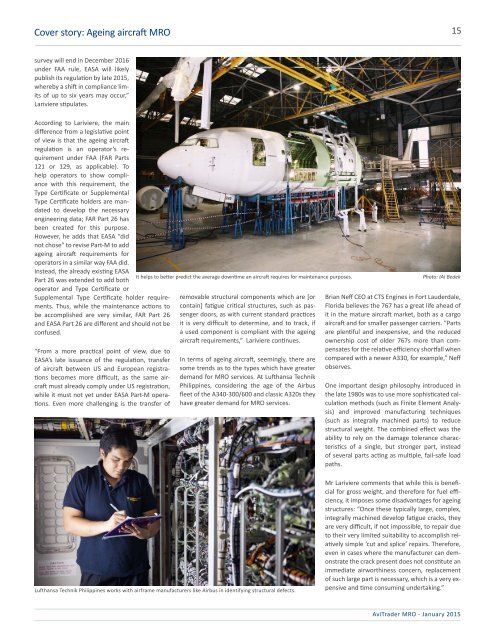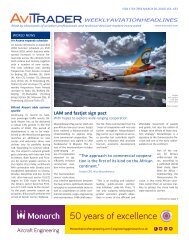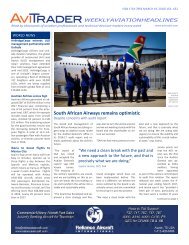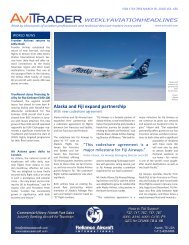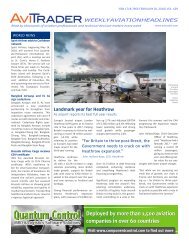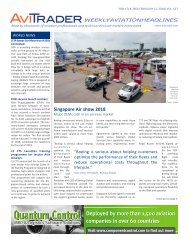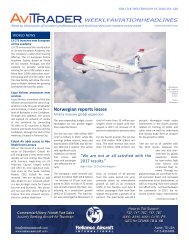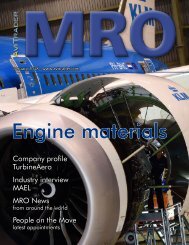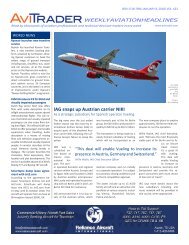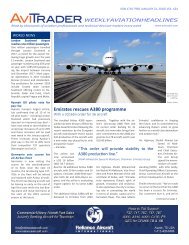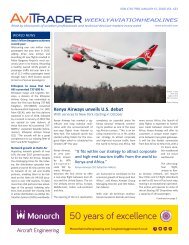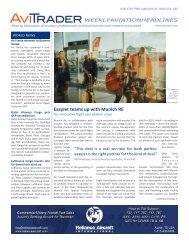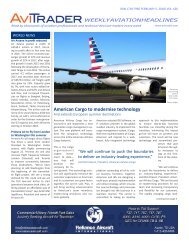AviTrader_Monthly_MRO_e-Magazine_2015-01
AviTrader_Monthly_MRO_e-Magazine_2015-01
AviTrader_Monthly_MRO_e-Magazine_2015-01
Create successful ePaper yourself
Turn your PDF publications into a flip-book with our unique Google optimized e-Paper software.
Cover story: Ageing aircraft <strong>MRO</strong><br />
15<br />
survey will end in December 2<strong>01</strong>6<br />
under FAA rule, EASA will likely<br />
publish its regulation by late <strong>2<strong>01</strong>5</strong>,<br />
whereby a shift in compliance limits<br />
of up to six years may occur,”<br />
Lariviere stipulates.<br />
According to Lariviere, the main<br />
difference from a legislative point<br />
of view is that the ageing aircraft<br />
regulation is an operator’s requirement<br />
under FAA (FAR Parts<br />
121 or 129, as applicable). To<br />
help operators to show compliance<br />
with this requirement, the<br />
Type Certificate or Supplemental<br />
Type Certificate holders are mandated<br />
to develop the necessary<br />
engineering data; FAR Part 26 has<br />
been created for this purpose.<br />
However, he adds that EASA “did<br />
not chose” to revise Part-M to add<br />
ageing aircraft requirements for<br />
operators in a similar way FAA did.<br />
Instead, the already existing EASA<br />
Part 26 was extended to add both<br />
operator and Type Certificate or<br />
Supplemental Type Certificate holder requirements.<br />
Thus, while the maintenance actions to<br />
be accomplished are very similar, FAR Part 26<br />
and EASA Part 26 are different and should not be<br />
confused.<br />
“From a more practical point of view, due to<br />
EASA’s late issuance of the regulation, transfer<br />
of aircraft between US and European registrations<br />
becomes more difficult, as the same aircraft<br />
must already comply under US registration,<br />
while it must not yet under EASA Part-M operations.<br />
Even more challenging is the transfer of<br />
It helps to better predict the average downtime an aircraft requires for maintenance purposes.<br />
removable structural components which are [or<br />
contain] fatigue critical structures, such as passenger<br />
doors, as with current standard practices<br />
it is very difficult to determine, and to track, if<br />
a used component is compliant with the ageing<br />
aircraft requirements,” Lariviere continues.<br />
In terms of ageing aircraft, seemingly, there are<br />
some trends as to the types which have greater<br />
demand for <strong>MRO</strong> services. At Lufthansa Technik<br />
Philippines, considering the age of the Airbus<br />
fleet of the A340-300/600 and classic A320s they<br />
have greater demand for <strong>MRO</strong> services.<br />
Photo: IAI Bedek<br />
Brian Neff CEO at CTS Engines in Fort Lauderdale,<br />
Florida believes the 767 has a great life ahead of<br />
it in the mature aircraft market, both as a cargo<br />
aircraft and for smaller passenger carriers. “Parts<br />
are plentiful and inexpensive, and the reduced<br />
ownership cost of older 767s more than compensates<br />
for the relative efficiency shortfall when<br />
compared with a newer A330, for example,” Neff<br />
observes.<br />
One important design philosophy introduced in<br />
the late 1980s was to use more sophisticated calculation<br />
methods (such as Finite Element Analysis)<br />
and improved manufacturing techniques<br />
(such as integrally machined parts) to reduce<br />
structural weight. The combined effect was the<br />
ability to rely on the damage tolerance characteristics<br />
of a single, but stronger part, instead<br />
of several parts acting as multiple, fail-safe load<br />
paths.<br />
Lufthansa Technik Philippines works with airframe manufacturers like Airbus in identifying structural defects.<br />
Mr Lariviere comments that while this is beneficial<br />
for gross weight, and therefore for fuel efficiency,<br />
it imposes some disadvantages for ageing<br />
structures: “Once these typically large, complex,<br />
integrally machined develop fatigue cracks, they<br />
are very difficult, if not impossible, to repair due<br />
to their very limited suitability to accomplish relatively<br />
simple ‘cut and splice’ repairs. Therefore,<br />
even in cases where the manufacturer can demonstrate<br />
the crack present does not constitute an<br />
immediate airworthiness concern, replacement<br />
of such large part is necessary, which is a very expensive<br />
and time consuming undertaking.”<br />
<strong>AviTrader</strong> <strong>MRO</strong> - January <strong>2<strong>01</strong>5</strong>


